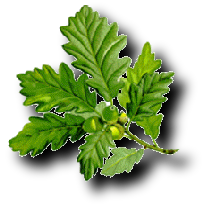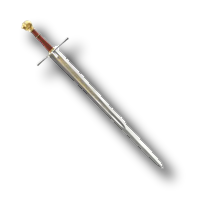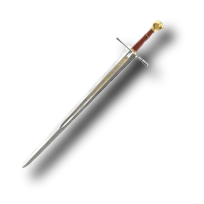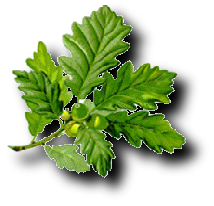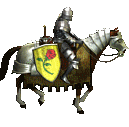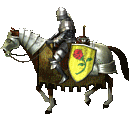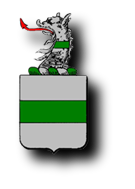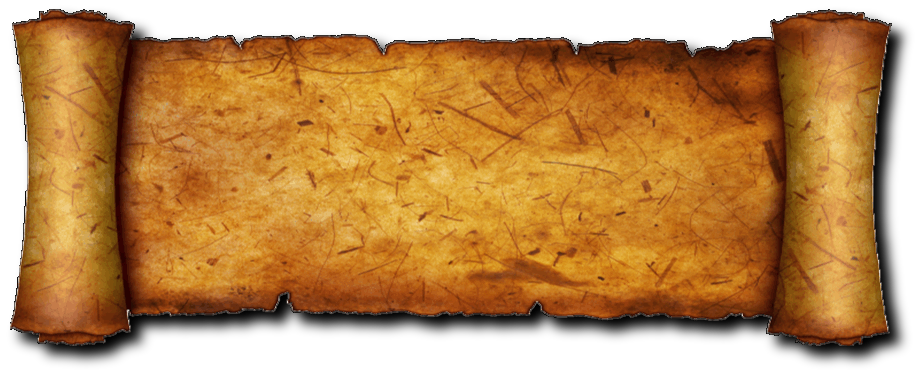

The Coat of Arms of the family Van Druten
Family coats of arms became common from the time of the crusades, at the end of the 11th century, when families took on family names that pointed to possession, position and such.In the beginning, a coat of arms was only put on the shield of the knight, later it was also used as an indication of possession of lands. It was passed on to descendants, in most cases to the firstborn son. Younger sons designed their own arms, usually making a change to, or an addition to, the coat of arms of the father.Originally, the coat of arms consisted only of the shield and a panel. Helmet decorations or other such items were later added to the arms, in many cases with even more elaborate decorations. The simplest coats of arms are therefore the oldest.Later, arms were not only carried on the shield, but also on the family seal, the helmet of the knight and many other items of the family possessions.The coat of arms of the ancient aristocratic family van Druten is a typical example of the development of the essance of heraldry. It existed long before the year 1300. Adding the word “DE” (of), which means “VAN” (from), to the family name, meant without a doubt, that the person had been made a knight and carried a weapon. This was the case regarding the first known forefather of the family, Rotgerus de Drutena, who was listed as a witness on a document of transfer of landtitle in about 1076.
Members of the family also carried seals. They were used to underscore the authenticity attached to important documents. In most cases the seal only showed an image of the original coat of arms without any embelishments, i.e., just the shield and panel, beneath the name of the family member.
Bearers of the Family name in the 16th and 17th centuries.
As has been revealed, the line of succession of castle lords in the domain Druten ended in the year 1483 with Willem Van Druten.There were a number of important bearers of the family name in the areas between the Maas and Waal rivers, as well as to the north of the Waal and in the east around Nijmegen at the end of the 15th century. There are, however, no documents regarding this line of the family.The reason for this, for example, is that many could not meet the requirements of the new order of knights at Nijmegen, established at the start of the 16th century, and, also it could not be verified with any certainty if they had remained in the area or, if they had any descendents.A major problem is the loss of large amounts of documents regarding the family history of many families in the Netherlands as a result of the intense and long religious wars of the mid 16th century, that carried on into the 17th century, and as a consequence it is impossible to trace the lineage of many to their forefathers of the 16th century. As is known, at that time there was no registration of births and deaths by government authorities.However, it is certain that the later bearers of the family name Van Druten are descended from the forefathers mentioned in the verified documents.Not many of the later family members remained in the land between Maas and Waal. Table V shows a list in chronological order. A list of family members, sometimes only fragmentary but still according to documentary evidence, is listed below.
1509 Jan van Druten,recorded in the books Schepenen at ‘s-Hertogenbosch.
He had 2 sons:
Wouter van Druten and Dirk van Druten.
Dirk was an alderman in Megen, near Druten. They are mentioned in relation to the sale of land. Dirk had a son and two daughters.
1542 The son:
Ceel (Marcelis) van Druten is mentioned in 1542.
He had 2 sons:
Wolter van Druten and Jan van Druten and 1 daughter.
1588/1560 – Wolter is mentioned in 1558 and in 1560 in regards to the sale of
land to his brother Jan. Jan is recorded in 1575 as the guardian for the children of his sister.
1551/1568 – In the monestary records of Grafental near Goch (Germany), mentioned in relation with a lease: Jordan van Druten, also: Wolter van Druten, the younger, no further details.
1566 Arriaen van Druten is recorded at Nijmegen as kinsman and representative of the family.
1603/1614 – Jan Janz.van Druten is recorded in 1603 is regards to the sale of land in the parish of Megen.
1618 Willem Gerritsz.van Druten, notary at Nijmegen, married Nieske van der Schilt. Four daughters are born to the couple.
1621 Steven Aertsen van Druten married Tijske Reijnen van Wissen at Nijmegen.
1631 Jan Jansen van Druten married Hubertje Arriaens, widow of Gerrit Doys. One son was born to the couple:
Arriaen Jansz.van Druten.
1660 Jan van Druten married Hendrikje Notten in Nijmegen. They had 4 sons and 3 daughters.
1660 Reinier van Druten, owner of “Het Botshuis”, took legal action against Duke Otto van Limburg-Bonkorst regarding the hunt on the extensive lands of Borculo (Bredevoirt). He won the lawsuit.
1678 Florentius van Druten signed an agreement with Gertruid van der Haer and the widow Elisabeth de Visscher.
1681 Otto van Druten married Henderken van Vuere in Nijmegen.
-----------------------
The reinstitution of church record keeping at the end of the religious wars in the beginning of the 17th century has made the investigation of new family lines from that period on much easier.As far as is known, this has only been done in one case, this being for the Tiel-Sneeker line. The initiators were the brothers Johan and Jan Jacobus van Druten, publishers in Utrecht and Sneek. It is the forefather of this line who is mentioned first, this as a result of the hiatus in investigations after the end of the earlier mentioned religious wars.
Bron/Source: Chronik Familien Verband “von Drathen” 1928
Family coats of arms became common from the time of the crusades, at the end of the 11th century, when families took on family names that pointed to possession, position and such.In the beginning, a coat of arms was only put on the shield of the knight, later it was also used as an indication of possession of lands. It was passed on to descendants, in most cases to the firstborn son. Younger sons designed their own arms, usually making a change to, or an addition to, the coat of arms of the father.Originally, the coat of arms consisted only of the shield and a panel. Helmet decorations or other such items were later added to the arms, in many cases with even more elaborate decorations. The simplest coats of arms are therefore the oldest.Later, arms were not only carried on the shield, but also on the family seal, the helmet of the knight and many other items of the family possessions.The coat of arms of the ancient aristocratic family van Druten is a typical example of the development of the essance of heraldry. It existed long before the year 1300. Adding the word “DE” (of), which means “VAN” (from), to the family name, meant without a doubt, that the person had been made a knight and carried a weapon. This was the case regarding the first known forefather of the family, Rotgerus de Drutena, who was listed as a witness on a document of transfer of landtitle in about 1076.
Members of the family also carried seals. They were used to underscore the authenticity attached to important documents. In most cases the seal only showed an image of the original coat of arms without any embelishments, i.e., just the shield and panel, beneath the name of the family member.
Bearers of the Family name in the 16th and 17th centuries.
As has been revealed, the line of succession of castle lords in the domain Druten ended in the year 1483 with Willem Van Druten.There were a number of important bearers of the family name in the areas between the Maas and Waal rivers, as well as to the north of the Waal and in the east around Nijmegen at the end of the 15th century. There are, however, no documents regarding this line of the family.The reason for this, for example, is that many could not meet the requirements of the new order of knights at Nijmegen, established at the start of the 16th century, and, also it could not be verified with any certainty if they had remained in the area or, if they had any descendents.A major problem is the loss of large amounts of documents regarding the family history of many families in the Netherlands as a result of the intense and long religious wars of the mid 16th century, that carried on into the 17th century, and as a consequence it is impossible to trace the lineage of many to their forefathers of the 16th century. As is known, at that time there was no registration of births and deaths by government authorities.However, it is certain that the later bearers of the family name Van Druten are descended from the forefathers mentioned in the verified documents.Not many of the later family members remained in the land between Maas and Waal. Table V shows a list in chronological order. A list of family members, sometimes only fragmentary but still according to documentary evidence, is listed below.
1509 Jan van Druten,recorded in the books Schepenen at ‘s-Hertogenbosch.
He had 2 sons:
Wouter van Druten and Dirk van Druten.
Dirk was an alderman in Megen, near Druten. They are mentioned in relation to the sale of land. Dirk had a son and two daughters.
1542 The son:
Ceel (Marcelis) van Druten is mentioned in 1542.
He had 2 sons:
Wolter van Druten and Jan van Druten and 1 daughter.
1588/1560 – Wolter is mentioned in 1558 and in 1560 in regards to the sale of
land to his brother Jan. Jan is recorded in 1575 as the guardian for the children of his sister.
1551/1568 – In the monestary records of Grafental near Goch (Germany), mentioned in relation with a lease: Jordan van Druten, also: Wolter van Druten, the younger, no further details.
1566 Arriaen van Druten is recorded at Nijmegen as kinsman and representative of the family.
1603/1614 – Jan Janz.van Druten is recorded in 1603 is regards to the sale of land in the parish of Megen.
1618 Willem Gerritsz.van Druten, notary at Nijmegen, married Nieske van der Schilt. Four daughters are born to the couple.
1621 Steven Aertsen van Druten married Tijske Reijnen van Wissen at Nijmegen.
1631 Jan Jansen van Druten married Hubertje Arriaens, widow of Gerrit Doys. One son was born to the couple:
Arriaen Jansz.van Druten.
1660 Jan van Druten married Hendrikje Notten in Nijmegen. They had 4 sons and 3 daughters.
1660 Reinier van Druten, owner of “Het Botshuis”, took legal action against Duke Otto van Limburg-Bonkorst regarding the hunt on the extensive lands of Borculo (Bredevoirt). He won the lawsuit.
1678 Florentius van Druten signed an agreement with Gertruid van der Haer and the widow Elisabeth de Visscher.
1681 Otto van Druten married Henderken van Vuere in Nijmegen.
-----------------------
The reinstitution of church record keeping at the end of the religious wars in the beginning of the 17th century has made the investigation of new family lines from that period on much easier.As far as is known, this has only been done in one case, this being for the Tiel-Sneeker line. The initiators were the brothers Johan and Jan Jacobus van Druten, publishers in Utrecht and Sneek. It is the forefather of this line who is mentioned first, this as a result of the hiatus in investigations after the end of the earlier mentioned religious wars.
Bron/Source: Chronik Familien Verband “von Drathen” 1928



Site is translated by my friend Johan Henzen, Australië .

